

4 gamification features that make Headspace worth it (according to 2 million users)
4 gamification features that make Headspace worth it (according to 2 million users)
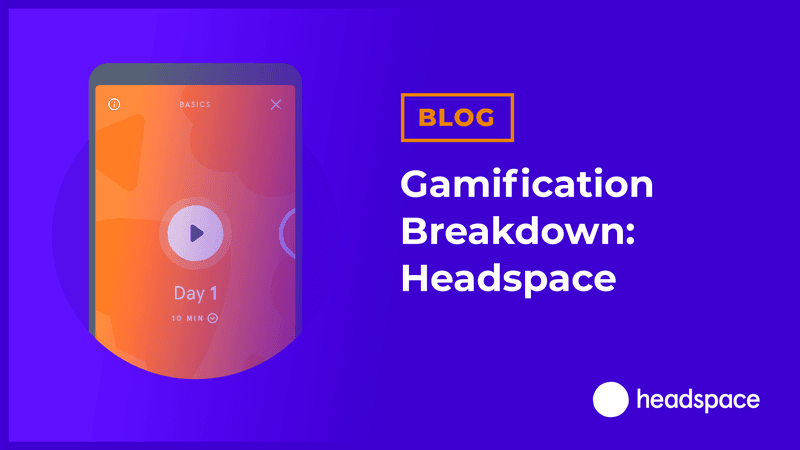
Headspace has become a leader in the wellness app market by effectively using gamification to encourage meditation habits and build a massive user base.
What started in a small London apartment is now a global phenomenon! Headspace, the meditation and wellness app, is today trusted by the likes of Google, LinkedIn, and Adobe to give their employees peace of mind. With gamification features that make meditation a habit, the app built a reward system that gives its users exactly what they’re looking for: peace of mind.
Not to mention, over 2 million paying subscribers use the app regularly.
Let’s take a look at what made Headspace so successful, and what you can learn from their success!
- 3 trends that define the Headspace success story
- How Headspace uses these gamification features to grow
- Create your own gamification strategy in 3 easy steps
- Recap
3 trends that define Headspace success story
Get this - 1 BILLION people will download wellness apps in 2021. That’s up 42% from last year, which itself was a record number! Clearly, mobile wellness is booming, and Headspace is riding that wave. In the first 3 months of 2021, Headspace brought in over $16 million - more than any previous quarter. So what is causing this enormous success?
#1 A growing awareness of mental health and wellness
Today, people are more likely than ever to discuss mental health, according to the New Economics Foundation. Unfortunately, the increase in attention might be linked to the increase in affliction. To demonstrate that, the rising cost of poor mental health on the world economy is set to more than double between 2010 and 2030, ballooning to $6 trillion a year. Given that, apps like Headspace fulfill a wellness need that is emerging with a higher priority each year that passes.
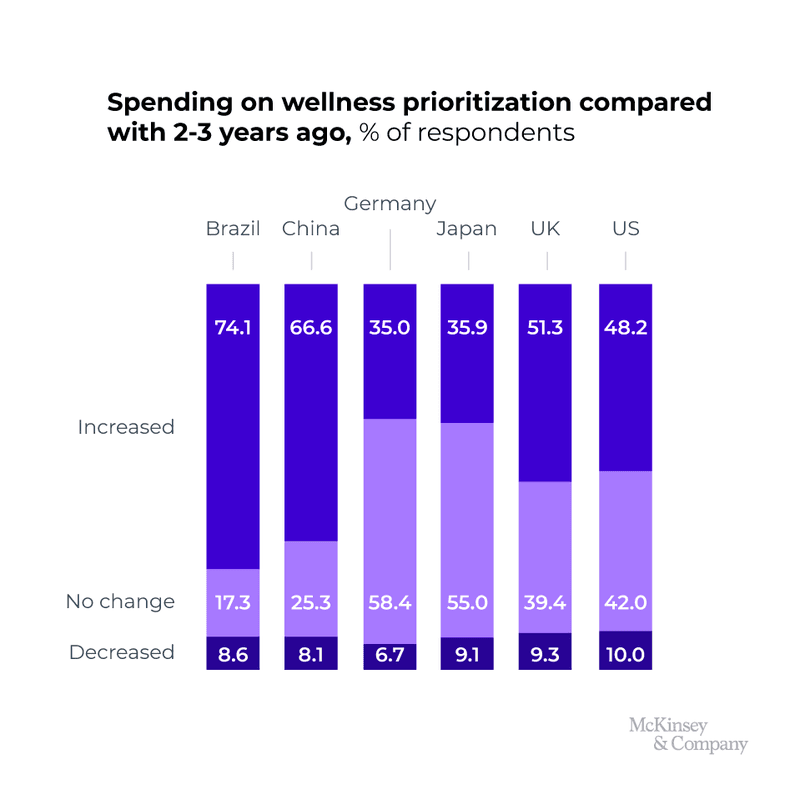
This graph illustrates the growing economic impact of poor mental health, a key driver behind the rising demand for wellness apps.
#2 Personalization is becoming a priority
According to the consulting firm McKinsey, now more than ever consumers want personal solutions. For instance, people want videos or courses tailored to their meditation or nutrition needs and habits. In the US, UK, and Germany, more than 88% of wellness consumers prioritize personalization over privacy. With the gamification features implemented by Headspace, such as custom meditation packs and the ability to add wellness ‘buddies’, the app has successfully tapped into this customer priority.
#3 The rise of services over products
For a long time, health and wellness companies have relied on the sale of products to generate revenue. However, recent advances in mobile access and digital literacy are drastically shifting the market. While products still dominate wellness spending, services (such as a Headspace subscription) are on the way up.
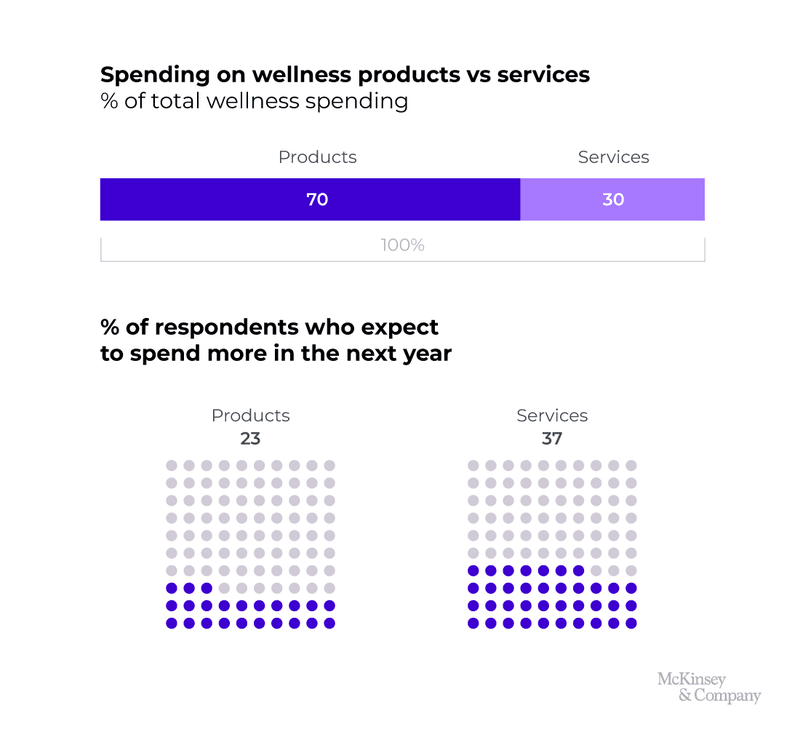
The chart highlights the market shift towards wellness services, a trend Headspace has successfully capitalized on with its subscription model.
What is gamification? Learn everything you need right here!
Anticipating these trends, Headspace has prepared itself for the future. Clearly, it is working. Not only did the app add 1 million paying subscribers between 2018 and 2020, but Headspace is increasingly popular with business customers too. In that same two-year time period, Headspace doubled its business customers from 300 to 600. Particularly given the rise in home-working, organizations are looking to install wellness programs to keep up employee satisfaction and productivity.
In the general wellness market, this success is being seen too. Business involvement in wellness shot up in 2021, achieving a record $4.2 billion across 153 deals. In conclusion, more companies want in!
How Headspace uses gamification features to grow
Whilst meditation is physically easy to practice, the biggest barrier to actually doing it is internal: a lack of motivation! How then, does Headspace motivate its users to meditate? By creating a habit! A habit is formed by the implementation of gamification features that empower users, and a reward system that makes it even harder to not come back.
Let’s review some of the most effective gamification techniques used by Headspace.
Enrich your own app with fun elements! Check out our app gamification software.
A fast and easy onboarding process makes users feel safe
To create a successful onboarding process, you should use as few screens as possible. Headspace manages to get it right in just 5 screens! When moving quickly, the user sees the value of the app faster. This is important, or else you may find you have a problem with early user churn!
To prevent that from happening, Headspace has a progress bar that shows how long until users can start using the app freely.
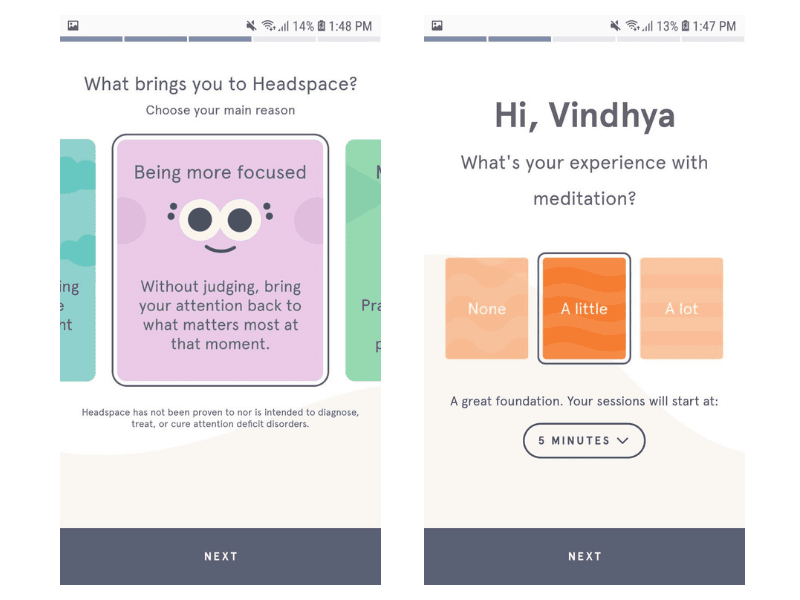
Headspace's simple, multi-screen onboarding process quickly shows value to the user, a key factor in reducing initial churn.
Free content for beginners entices users to join and pay
At a glance, giving things away for free might not make immediate sense. However, it is true that offering gratuities results in a more likely conversion. To explain, there are two underlying mechanics that make this a winning feature - reciprocity and constraint.
Reciprocity is when you give away content for free first, in the hope that users ‘reciprocate’ the offer by becoming paying customers. Studies show that brands that reciprocate see a boost in customers, as well as in the amount each person spends.
The other mechanic is ‘constraint’. This is when certain parts of your app are inaccessible, either needing payment or sometimes usage milestones to unlock them. It pays to know the psychology behind why constraint is so powerful. Simply put, people don’t like to miss out!
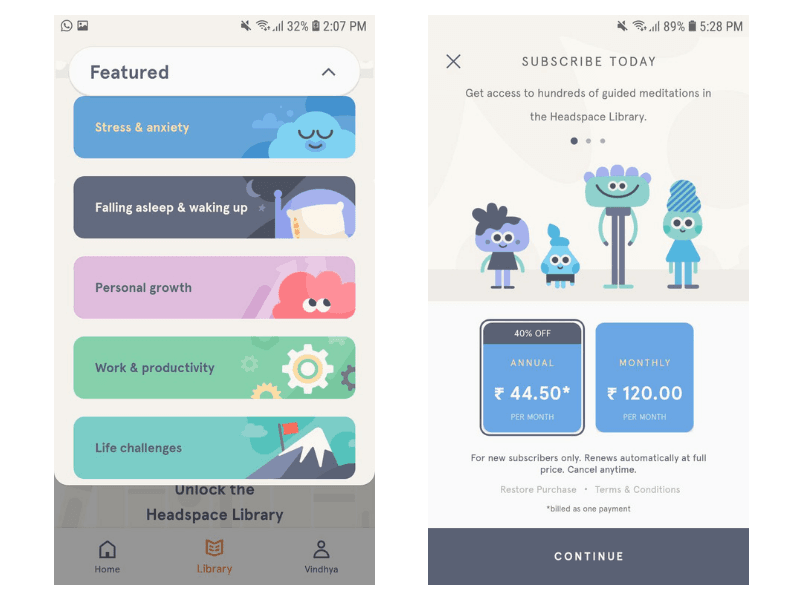
This example of constrained content effectively uses the psychological principle of reciprocity to entice users to upgrade to a paid subscription.
A leaderboard with ‘no leaders’ encourages socialization and habit formation
Above all, Headspace wants you to take it easy. For sure, this approach is followed by a leaderboard function. While it looks like a leaderboard, there are no leaders. Instead, you can only see who among your ‘buddies’ has used the app today. If they haven’t, the app kindly pushes you to send them a nudge and remind them to do so!
Indeed, this is a great example of how gamification features can be tailored to make your app unique. Headspace’s leaderboard is appropriately low stress and low stakes, and it retains all the benefits of a conventional leaderboard! Firstly, users will profit from the social interaction that a leaderboard fosters. As well, the focus on daily usage encourages subscribers to form a habit for both themselves and their buddies.

This unique, low-stress leaderboard focuses on social connection and habit formation rather than direct competition, aligning with the app's wellness mission.
Streaks and badges form a reward system that gives users positive reinforcement (and why they can’t share them)
Ultimately, Headspace wants you to form a habit. A fantastic way of doing that is with the streak feature. Just 15 sessions earn a month’s free subscription for a friend! This prize and positive validation give users good feelings, a reward system that makes the app intrinsically motivating to use.
By celebrating achievements early on, users feel what is called the ‘endowed progress effect’, which notes that when people feel they have made progress towards a target, they will become more motivated to achieve it.
The badge system is also built to give users positive emotions. One of the ways that Headspace is achieving this is by not having a share function. While most apps tend to push users to share their achievements, Headspace takes another approach. Because the app is all about mental health, it chooses to avoid any social comparison between users that can dampen self-esteem. In this way, users can see their badges and feel like they have achieved something, without needing to measure themselves against their peers.
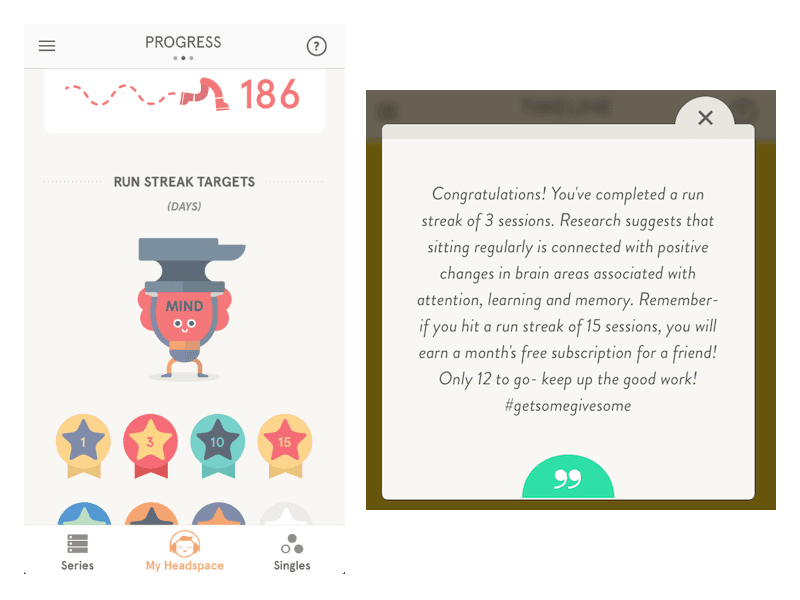
The rewards system, featuring streaks and non-shareable badges, provides positive reinforcement without fostering negative social comparison.
How to set up your own gamification strategy in 3 easy steps
In just 3 hours and 3 easy steps, StriveCloud workshops can map out the perfect journey for your custom app gamification strategy. Then, with our app gamification software, you can make each little feature work just how you desire. It’s simple to get started:
- Book your workshop. Together with your team, our gamification experts will explore your app, its functionality and target audience, your growth goals, and the obstacles currently blocking your path.
- Bring your data. We’ll help you analyze your user journey to discover where the biggest wins will be. This will depend on what you prioritize: activation, retention, or engagement. Of course, we’ll tell you what you need in advance.
- Make a plan. Once the key elements of your app have been analyzed, and we have discussed how your product can harness the benefits of gamification, it’s crunch time. We’ll show you the exact tactics we’ve previously used to boost daily active users by 58% and increase user retention by as much as 23%.
With this plan, you’ll know exactly which next steps to take to drive user motivation and retention of your app!
Rev up your app growth strategy with an interactive gamification workshop tailored to your business needs!
Recap
What started in a small London apartment is now a wellness app trusted by the likes of Google, LinkedIn, and Adobe to give their employees peace of mind. Not to mention, Headspace has over 2 million paying subscribers who use the app regularly!
How did Headspace do it? By aligning with today’s trends:
#1 A growing awareness of mental health and wellness. Society has never been more aware of mental health. In fact, it costs the world economy $6 trillion a year. That’s more than a double increase between 2010 and 2030.
#2 Personalization is becoming a priority. More than 88% of wellness consumers prioritize personalization over privacy. This includes tailored courses and videos.
#3 The rise of services over products. Increased access to mobile apps has created a new platform for wellness services. Spending on services is rising, compared to products.
In anticipating these trends, Headspace is excelling - prepared itself for the future. The app doubled both individual and business customers between 2018 and 2020!
How Headspace uses gamification features to grow:
- Simple onboarding gets users to value faster. The Headspace onboarding process only consists out of 5 screens and a progress bar. Keeping it simple allows them to decrease the ‘cognitive load’, making the onboarding process feel even smoother.
- Free beginner content entices users to start meditating and eventually upgrade to paid plans. Offering gratuities prompts users to ‘reciprocate’ by becoming paying customers. Studies show that brands that reciprocate see a boost in customers!
- A low-stakes leaderboard encourages socialization. On this kind of leaderboard, there are no rankings. Instead, you can only see which of your ‘buddies’ has used the app today. If not, the app asks you to remind them! Although this is low stress and low stakes, users still profit from social interaction and habit formation.
- Badges give users positive reinforcement (and they can’t share them). The badge reward system is built to give users positive emotions. By not having a share function, Headspace ensures users avoid any social comparison between peers that can dampen self-esteem.
Create your own gamification strategy in 3 easy steps
In just 3 easy steps, a StriveCloud workshop can map out your gamification strategy:
- Book your workshop with us. Our experts will explore every aspect of your app.
- Bring your data. We’ll analyze how to optimize the user journey to suit your goals.
- Make a plan. We’ll show you some gamification examples and tactics from leading apps, and teach you how to execute them correctly!
With this plan, you’ll know exactly which next steps to take to drive user engagement and retention of your app!
How to shape your app so users can’t put it down? Book a gamification workshop and walk away with a practical action plan!
Related Posts
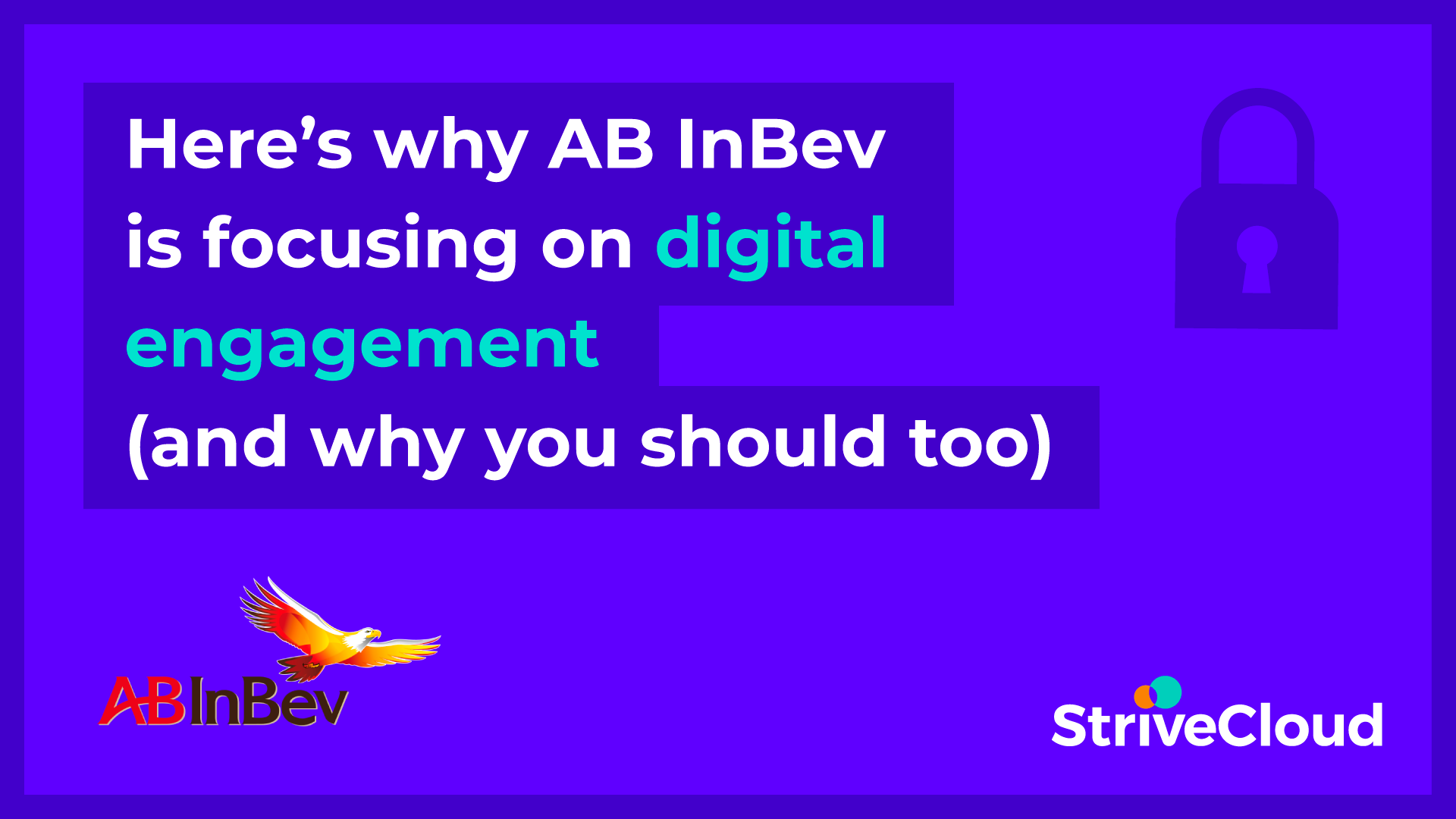
Interview: Here’s why AB InBev is focusing on digital engagement (and why you should too)
AB InBev, the biggest brewery in the world and also an avid sponsor of live sports events, is shifting focus to better serve its customers during the Corona outbreak. We had the opportunity to interview the AB InBev Europe innovation lead Michael Codd about handling communication, digital brand activation and esports.


